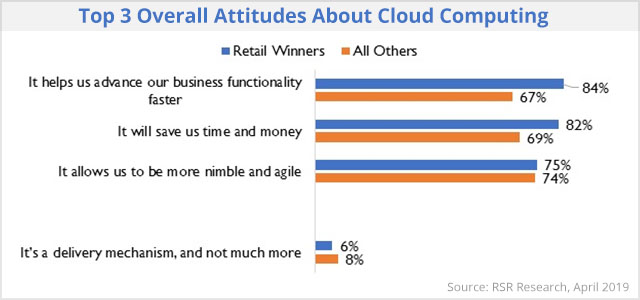
Photo: @criene via Twenty20
Is it time to push the ‘go faster’ button on cloud computing?
Through a special arrangement, what follows is a summary of an article from Retail Paradox, RSR Research’s weekly analysis on emerging issues facing retailers, presented here for discussion.
RSR’s first-ever benchmark on the state of cloud computing in retail finds that the top expected benefits from the cloud for retailers are improving speed and agility while maintaining manageable costs.
That ran counter to our going-in presumption that the driving force behind cloud adoption was the ability to flex with sudden seasonal or promotional volume spikes. Indeed, cloud as a pure delivery mechanism falls to the bottom of the list.
There’s some interesting energy behind that finding. The two groups that are typically charged with deploying business applications — the IT organization and the e-commerce group — are the ones that retailers want to adopt a cloud strategy.

It’s fair to point out that about one-half of our survey’s respondents come from the IT discipline itself: a whopping 98 percent of IT respondents report they can make the best use of cloud. IT, however, is the top beneficiary, according to 60 percent of non-IT respondents, as well.
The inference is clear: Year-after-year of complaints about the ever-growing IT backlog has taken a toll and retailers see the cloud as a way to accelerate technology-driven improvements to the business. Cloud is retailers’ real attempt to move beyond “retail time” to consumer time.
For over-performing retail winners, the challenges cloud computing is expected to address include:
- The need for more speed and agility
- Keeping up with customer wants and needs
- Becoming a 24X7 business
- Gaining flexibility to adopt or abandon solutions faster
- Pressures to cut costs
In the full report, we warn retailers against thinking of cloud-based solutions as a “magic bullet.” Indeed, retailers seem overly optimistic about their ability to layer cloud-based solutions over legacy systems without integration challenges.
There is other evidence in the report, however, that retailers are taking a sober approach to the cloud. For example, “performance and SLA compliance” rates as a top concern, followed closely by “keeping cloud costs in check.” These issues are closely related, since poor performance will inevitably trigger additional unanticipated costs to rectify the problem.
Discussion Questions
DISCUSSION QUESTIONS: Have expectations around what cloud operating platforms can deliver for retailers changed over the years? What should be the primary concerns about cloud adoption at this point?


When having these discussions, it is imperative that one establish the definition of the subject at hand. What was the definition of “cloud computing” when the survey was conducted and were the respondents told what the definition was? It is very difficult to provide an opinion without such a definition.
Expectations have absolutely changed. The concerns around early cloud-based offerings revolved around data security and lack of control. Those issues are brought up far less often. In our own CxO study, we had similar results around the top perceived benefits of cloud-based solutions so clearly the industry has become comfortable with cloud adding value to the business. Primary concerns still revolve around potential cost overruns as while things like cloud-based microservices can add flexibility and agility, one-off additions can add up and be more expensive in the end.
The argument for cloud computing has already been won. The question now is whether retailers will move there quickly enough. Cloud is changing the personality of IT shops across the industry.
Moving to a cloud-based management platform is the only scalable and secure solution for retailers with many remote sites. The cloud is the only cost-effective way for retailers to deploy new technologies and alleviate the fear of “what’s coming next?”
Now that the majority of the retail industry has pushed beyond their earlier cloud computing apprehensions, the technology is widespread and adding significant value for both companies and consumers. Cloud computing has proven to reduce costs, mitigate large investments in on-site servers, and has increased retail organizations’ abilities to scale and expand as they grow strategically.
With that said, the expectations are higher than ever, especially from a customer experience perspective. As we know, every retailer and brand should formulate their cloud and performance strategies around improving the customer’s online experience and especially the mobile experience. Speed matters more than ever, and there is zero tolerance from customers as it relates to online/mobile speed.
Both the IT organization and the e-commerce group need clear direction and understanding from the C-suite (especially at public companies) to the three to 10 year plan. The time to react has passed. The future is already here and instead, most retailers are wondering how to AI/ML. Cloud computing costs are definitely a factor without a plan. A truly rhetorical statement!
Edge computing is here A few items the C-suite, IT and e-commerce groups can aspire to utilize the cloud to edge computing for:
sentiment analytics via the cloud to edge devices, including voice commerce like Alexa;
I see two sides to the cloud. Going faster in terms of procuring on-demand infrastructure and making some types of applications more affordable (BI – heavy but non-continuous use of resources) and solution functionality – time to deployment. No question on a benefit from the first one. Are the applications that are cloud-ready at a point of functional superiority at this point? The answer to that one may not be uniform.
In the context of “go faster,” cloud computing can be economically (and strategically) sound for mature data science teams in an analytically driven company that is constantly exploring new data sources and running AB tests on large data sets in an often unpredictable manner.
At the end of the day, cloud computing is an essential component to consider in the context of an enterprise data and analytics strategy that can vary widely from one retailer to another.
I think there are many places for cloud adoption but one has to be specific to what the area is. For corporate applications I think with the move to the cloud to reduce admin requirements and get the latest features, there is less friction. For store-based application it depends on the location. You still have the issue of cost and reliability of connectivity though that has greatly improved in the last 10 years.
The expectations for the benefits of cloud computing platforms probably haven’t changed much over the years. What is changing is retailers’ openness to move to the cloud. In the past, many retailers were reluctant to take cloud-based platforms seriously because they had concerns with the reliability of their network, which is a critical component to ensure uptime and processing speed.
Networks have improved dramatically and with a robust, fast, reliable and resilient network, moving more applications to the cloud is a compelling proposition – especially with advanced SD-WAN solutions optimize the network performance and ensures 100 percent uptime.
I think the primary concern for retailers should be to focus on the store. Brian talks about consumer time — the store is where the big benefit is waiting to be had. How can you have consumer time without real time? You can’t. We have to break the decentralized store model and approach the 85 percent of all retail that takes place within those four walls with cloud-based POS solutions that are real-time and consumer-centric.
As we continue to learn from successful adoptions of cloud, we find that the hybrid and multi-cloud environments are taking hold in organizations of all sizes. Seamless interoperability is critical as more applications move off-premise.
Cloud computing is a given now for most retailers. Studies around cloud adoption and migration we have conducted in recent years generally agree with RSR’s findings.
We have found the top challenge now faced by retailers adopting cloud apps is in managing the performance of those applications down to the store level. While security and risk of outages (e.g. availability) used to top the list, it’s now all about how to maintain the high-performance levels necessary to not only ensure operational readiness for new in-store experiences but also to guarantee the customer experience is delivered with consistency and optimally at all timed across all stores.
The #1 factor our studies have shown that contributed to this challenge is the store network. Nearly three-quarters of retailers have told us their store network is the top culprit in hurting their ability to deliver great app performance, especially from the cloud. This is in large part due to these networks having been neglected for many years — they lack the capacity/bandwidth and resource controls needed to properly deliver on business needs. This is a readily solvable problem today with available services, but retailers need to realize this should be addressed in the planning process and not after the fact when deploying new in-store experiences and technology.
I feel there is huge danger of cloud being seen as a “silver bullet” to solve all problems. I have seen cloud move from being an area of concern for central IT (as “shadow IT” started to use cloud services) to being seen as a way to focus on core business and have someone else deal with the hardware. The dominance of AWS has led to concerns — but this is becoming less so as more choice appears.
Cloud offers huge possibilities for retailers to add new capabilities and differentiate themselves without the risk of having to replace all on-premise systems. This makes integration (from on-premise to cloud, cloud to cloud) absolutely critical and central to everything (the smart people of Salesforce.com saw this and this is why they paid so much for the acquisition of Mulesoft).
The difficulty is, ensuring that neither use of cloud or your integration strategy constrains you in any way. You need to be able to avoid being “locked in” — restricted to only use certain clouds or not being able to connect application in cloud A to application in cloud B.